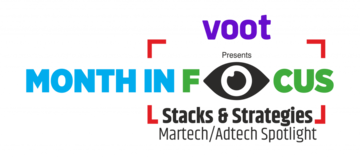
Advances in Artificial Intelligence and these evolving media channels could result in marketers increasingly tying together products, consumer experiences and advertising experiences, Kate Scott-Dawkins, Global Director, Business Intelligence, GroupM, tells Storyboard18 in a conversation about the ways in which AI-enabled advertisements will shape the future of consumer targeting.

According to GroupM's report Next10-AI on the technologies and behavior that will shape advertising over the next decade, AI-enabled advertising will be 90 percent of all advertising by the year 2032. Could you define this AI-enabled advertising? What is the current size of AI-enabled advertising and what is the headroom for growth?
We spent a lot of time talking to various experts across the GroupM & WPP network about how we were using the term artificial intelligence and how it’s being implemented across various categories and we took a high level, broad definition which includes a lot of technologies and tools that are under the umbrella of AI, so others include machine learning which are present in platforms like Google, Meta and Amazon, it helps match search intent with advertising and search results. It helps in optimizing and targeted campaigns and also includes things like natural language processing and what we have found is that all of these technologies are being used together quite heavily in advertising today, so we estimate that 45 percent of ad revenues or over $370 billion is AI informed or AI enabled and that’s going to climb to roughly $1.3 trillion or more than 90 percent of all advertising by the year 2032.
So if 90 percent of all advertising will be AI enabled, how will the advances in AI and evolving media channels help marketers through different product categories and sectors like auto, CPG (consumer packaged goods), etc?
What we are going to see is more marketers tying together the use of AI across the products, across customer experience, across advertising experience. In CPG, brands are already experimenting with personalized nutrition or more personalized beauty products, another category like retail, something like computer vision is going to have a huge impact changing the way consumers search for products, the way brands advertise for products and the sources of competition in the marketplace. The future could be searching the product through image rather than text and I think that’s an area where a lot of brands today still aren’t very mature and AI is going to change the way they advertise their products.

There is a growing clamour for data privacy and data safety, and now with the deprecation of third party cookies, what are the challenges a marketer could face and how can AI-enabled solutions help the marketer in targeting the right audience?
This is a source of inherent tension in the industry. On one hand we believe in delivering personalized and relevant advertising to people and on the other hand the direction of travel for most of the world is towards greater data privacy before audiences will give their information to a publisher or advertisers. So it’s really about figuring out how these two things can co-exist, one of them is creating relevance without using personal data like contextual targeting where AI can be used to match content on a page to a customized ad creative. We are also heavily using things like data clean rooms within platforms like Google or Meta where they are aggregating and anonymizing users and AI then within that system without being able to identify any one person figure how to reach those anonymized audiences within that platform.
Also, with programmatic ad buying one of the major concerns has been ad placement and brand safety. One of the things to avoid that, is buying from PMPs (private marketplace) or TMPs. However, it is still not where the bulk of transactions take place, because of the efficiency that open marketplace offers like quick targeting of the audience. Does this create a dangerous environment for brand safety?
Every brand has its own goals and risk tolerance, so certainly one size doesn’t fit all. What we want to see is a blending of costs and suitability. We do want a world where advertising can show up against news content in the open marketplace even if that content is not necessarily sunshine and roses. But, we haven’t seen real evidence of consumers having seen a long-term negative impact of viewing advertising against that kind of content. So there are places where AI can be very useful where advertising is totally problematic or isn’t right, especially as the processing and understanding of language gets better in terms of avoiding places like news or social media.
How do you see Web 3.0 impacting programmatic ad buying? Blockchain has been a solution for ad fraud for a few years. Web 3.0 builds solutions on blockchain and has decentralized data because of it, which will empower the consumers. What role will AI play in this transformation of marketing?
Few years ago some folks said that blockchain will be a solution for ad fraud but it hasn’t answered that fully yet. So, as GroupM, one of the largest media buyers and with our ability to help shape the future of advertising to work better for people, advertisers and publishers, we want AI to augment human intelligence rather than just automate things and replace humans.
First Published: Jun 14, 2022 10:28 AM IST
Note To Readers
Storyboard18’s new Month In Focus initiative spotlights themes and topics that are pushing marketers to reshape and rethink how brands interact with today’s customers. Our theme for this month is Stacks & Strategies, a martech and adtech spotlight on how decision makers and marketers are advancing the adoption of new technologies and tech-driven strategies in the brand marketing ecosystem. From the defining trends and preparing for a cookiepocalypse to how progressive martech strategies help fast track business and brand growth. Catch this special on Storyboard18.
Check out our in-depth Market Coverage, Business News & get real-time Stock Market Updates on CNBC-TV18. Also, Watch our channels CNBC-TV18, CNBC Awaaz and CNBC Bajar Live on-the-go!


PM Modi visits Ram Mandir for first time since 'Pran Pratishtha', offers prayers before roadshow
May 5, 2024 8:59 PM
Visiting temples, obliging selfie requests, jabbing rivals – Kangana Ranaut is wooing voters on campaign trail
May 5, 2024 8:23 PM

